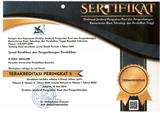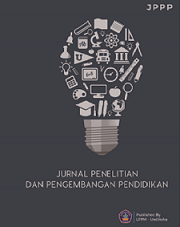Radar Tasikmalaya News Portal's Error Analysis in the Indonesian Language from a Linguistic Category Point of View
DOI:
https://doi.org/10.23887/jppp.v7i3.67575Keywords:
Language Error, Linguistic Category, Tasikmalaya Radar NewsAbstract
There are still many online news portals that make writing errors, not only in terms of spelling, but also in terms of morphology, syntax and semantics. The goal of this language mistake analysis is to analyze and repair phonological, morphological, syntactic, and semantic faults found on instructional pages of the Radar Tasikmalaya news site. The researcher employed a descriptive analytic method. The research methods employed in this study were observation, interviews, and literature studies, which involved reviewing all of the books, articles, notes, and reports that had anything to do with the issue being addressed. By performing numerous steps in the study process, including: (1) gathering data, (2) describing the data, (3) evaluating the data, and (4) drawing conclusions. The findings of a language mistake study for the Radar Tasikmalaya news portal's edition can be concluded that there are forms of language errors in the fields of phonology, morphology, syntax, and semantics. In linguistic-morphological category errors there are errors in affixation. Syntactic errors consist of errors in sentence construction. There are also semantic errors consisting of errors in the meaning of sentences that can make the reader misinterpret the sentence. Then there are errors in the use of spelling or phonology, these spelling errors consist of writing errors in the use of punctuation marks, especially in writing academic degrees, using standard words, writing foreign terms, and writing capital letters.
References
Al-Sobhi, B. M. S. (2019). The Nitty-gritty of Language Learners’ Errors – Contrastive Analysis, Error Analysis and Interlanguage. International Journal of Education and Literacy Studies, 7(3), 49. https://doi.org/10.7575/aiac.ijels.v.7n.3p.49. DOI: https://doi.org/10.7575/aiac.ijels.v.7n.3p.49
Allen, H. W., & Paesani, K. (2022). Genre instruction, textual borrowing, and foreign language writing: Graduate teaching assistant perspectives and practices. Language Teaching Research, 26(4), 755–776. https://doi.org/10.1177/1362168820911194. DOI: https://doi.org/10.1177/1362168820911194
Atmaca, Ÿ. (2016). Error Analysis of Turkish EFL Learners: A Case Study. Procedia - Social and Behavioral Sciences, 232, 234–241. https://doi.org/https://doi.org/10.1016/j.sbspro.2016.10.007. DOI: https://doi.org/10.1016/j.sbspro.2016.10.007
Bar-Kochva, I., Vágvölgyi, R., Dresler, T., Nagengast, B., Schröter, H., Schrader, J., & Nuerk, H. C. (2021). Basic reading and reading-related language skills in adults with deficient reading comprehension who read a transparent orthography. Reading and Writing, 34(9), 2357–2379. https://doi.org/10.1007/s11145-021-10147-4. DOI: https://doi.org/10.1007/s11145-021-10147-4
Bayyurt, Y. (2016). Current perspectives on sociolinguistics and English language education. The Journal of Language Teaching and Learning, 3(1), 69–78. https://dergipark.org.tr/en/pub/jltl/issue/22506/240603.
Boddaert, G., Cornut, C., & Casalis, S. (2021). Integration of newly learned L2 words into the mental lexicon is modulated by vocabulary learning method. Acta Psychologica, 212, 103220. https://doi.org/10.1016/j.actpsy.2020.103220. DOI: https://doi.org/10.1016/j.actpsy.2020.103220
Dervis, B. (2013). Library Research Method. Journal of Chemical Information and Modeling, 53(9), 1689–1699. https://muse.jhu.edu/article/202353/summary. DOI: https://doi.org/10.1021/ci400128m
Dewi, E. E., Huda, K., & Supriyatno, S. (2019). An Analysis Of Euphemism In Online Written Mass Media In Indonesia; Jakarta Post And Republika Newspaper In Political Section. Edulitics (Education, Literature, and Linguistics) Journal, 4(1), 46–53. https://doi.org/10.52166/edulitics.v4i1.1567.
Dewi, F. S., & Huda, M. C. (2020). An Analysis of Students ’ Errors in Writing Descriptive Text at Tenth Grade of SMAN 1 Tulungagung in Academic Year 2018 / 2019. A Journal of English Language Teaching, Linguistics, and Literature, 3(1), 11–20. https://www.academia.edu/download/87227928/1544-3105-2-PB.pdf.
Dowell, N. M. M., Lin, Y., Godfrey, A., & Brooks, C. (2020). Exploring the relationship between emergent sociocognitive roles, collaborative problem-solving skills, and outcomes: A group communication analysis. Journal of Learning Analytics, 7(1), 38–57. https://doi.org/10.18608/jla.2020.71.4. DOI: https://doi.org/10.18608/jla.2020.71.4
Eckstein, G., & Ferris, D. (2018). Comparing L1 and L2 Texts and Writers in First-Year Composition. TESOL Quarterly, 52(1), 137–162. https://doi.org/10.1002/tesq.376. DOI: https://doi.org/10.1002/tesq.376
Harefa, D. T., Anggraini, M., & Rasyid, Y. (2022). Analysis of Language Error at Morphological Level on Covesia. com Online News Portal. In Proceeding of International Conference on Language Pedagogy (ICOLP), 2(1), 71–81. https://proceeding-icolp.fbs.unp.ac.id/index.php/icolp/article/view/72.
Hikmah, D. (2019). Media for language teaching and learning in digital era. International Journal of English Education and Linguistics (IJoEEL), 1(2), 36–41. http://download.garuda.kemdikbud.go.id/article.php?article=1475725&val=17767. DOI: https://doi.org/10.33650/ijoeel.v1i2.963
Hussen Maulud, D., Zeebaree, S. R. M., Jacksi, K., Mohammed Sadeeq, M., & Hussein Sharif, K. (2021). State of Art for Semantic Analysis of Natural Language Processing. Qubahan Academic Journal, 1(2), 21–28. https://doi.org/10.48161/qaj.v1n2a40. DOI: https://doi.org/10.48161/qaj.v1n2a44
Islamiyah, M., & Fajri, M. S. Al. (2019). Error Analysis and Its Implications for the English Classroom : A Case Study of an Advanced English Learner. Indonesian EFL Journal: Journal of ELT, Linguistics, and Literature, 5(2), 1–13. http://ejournal.kopertais4.or.id/mataraman/index.php/efi/article/view/3736.
Kweldju, S. (2021). Incorporating linguistic landscape into English word-formation task in an English Morphology class. TEFLIN Journal, 32(1), 29–49. https://doi.org/10.15639/teflinjournal.v32i1/29-49. DOI: https://doi.org/10.15639/teflinjournal.v32i1/29-49
Le, T. D., Dobele, A. R., & Robinson, L. J. (2019). Information sought by prospective students from social media electronic word-of-mouth during the university choice process. Journal of Higher Education Policy and Management, 41(1). https://doi.org/10.1080/1360080X.2018.1538595. DOI: https://doi.org/10.1080/1360080X.2018.1538595
Mantiri, O. (2015). Factors Affecting Language Change. SSRN Electronic Journal, March 2010. https://doi.org/10.2139/ssrn.2566128. DOI: https://doi.org/10.2139/ssrn.2566128
Mustadi, A., & Amalia, M. (2020). Spelling Writing Error Analysis in Nonfiction Essay of Elementary Students. Jurnal Prima Edukasia, 8(2), 177–187. https://doi.org/10.21831/jpe.v8i2.33436. DOI: https://doi.org/10.21831/jpe.v8i2.33436
Parlato-Oliveira, E., Chetouani, M., Cadic, J.-M., Viaux, S., Ghattassi, Z., Xavier, J., Ouss, L., Feldman, R., Muratori, F., Cohen, D., & Saint-Georges, C. (2020). The emotional component of Infant Directed-Speech: A cross-cultural study using machine learning. Neuropsychiatrie de l’Enfance et de l’Adolescence, 68(2), 106–113. https://doi.org/10.1016/j.neurenf.2019.10.004. DOI: https://doi.org/10.1016/j.neurenf.2019.10.004
Pasaribu, A. N. (2021). A Common Error Analysis in Students’ English Narrative Writing. English Education and Art (LEEA) Journal, 4(2), 436–445. https://doi.org/10.31539/leea.v4i2.2338. DOI: https://doi.org/10.31539/leea.v4i2.2338
Pittman, R. T., Zhang, S., Binks-Cantrell, E., Hudson, A., & Joshi, R. M. (2020). Teachers’ knowledge about language constructs related to literacy skills and student achievement in low socio-economic status schools. Dyslexia, 26(2), 200–219. https://doi.org/10.1002/dys.1628. DOI: https://doi.org/10.1002/dys.1628
Putri, I. G. A. V. W., & Santika, I. D. A. D. M. (2020). The Emotional Lexicon Used by Male and Female Communication: Study of Balinese Language Used in South Kuta-Bali. Linguistic, English Education and Art (LEEA) Journal, 3(2), 364–372. https://doi.org/10.31539/leea.v3i2.1177. DOI: https://doi.org/10.31539/leea.v3i2.1177
Rahman, R., Sopandi, W., Widya, R. N., & Yugafiati, R. (2019). Literacy in The Context of Communication Skills for The 21st Century Teacher Education in Primary School Students. International Journal of Science and Applied Science: Conference Series, 3(1), 101. https://doi.org/10.20961/ijsascs.v3i1.32462. DOI: https://doi.org/10.20961/ijsascs.v3i1.32462
Reistanti, A. (2018). Analysis of language errors in writing fables by Grade VIII E students at SMP 2 Muhammadiyah Surakarta. Linguistic and Literary Studies, 2(2), 126–140. http://journals.ums.ac.id/index.php/KLS. DOI: https://doi.org/10.23917/kls.v2i2.6735
Rosenbaum, S., & Patti, S. (2016). Speech and Language Disorders in Children: Implications for the Social Security Administration’s Supplemental Security Income Program. 305. https://doi.org/10.17226/21872. DOI: https://doi.org/10.17226/21872
Salifu, N. A. (2010). Signaling Politeness, Power and Solidarity through Terms of Address in Dagbanli. Nordic Journal of African Studies, 19(4), 274–292. https://doi.org/10.53228/njas.v19i4.198.
Setyaningsih, Y., & Rahardi, R. K. (2020). Reduplication of Word Class of Indonesian Prosedic Morphology: Towards a Semantico-Pragmatic Perspective. Jurnal Kata, 4(1), 167. https://doi.org/10.22216/kata.v4i1.5249. DOI: https://doi.org/10.22216/kata.v4i1.5249
Shanks, J. D., Izumi, B., Sun, C., Martin, A., & Shanks, C. B. (2017). Teaching undergraduate students to visualize and communicate Public Health data with infographics. Frontiers in Public Health, 5(NOV), 1–6. https://doi.org/10.3389/fpubh.2017.00315. DOI: https://doi.org/10.3389/fpubh.2017.00315
Taylor, P. C. (2011). Qualitative Research in Postmodern Times (D. Bridges (ed.); 33rd ed.). Sense Publisher.
Van Lier, L. (2010). The ecology of language learning: Practice to theory, theory to practice. Procedia - Social and Behavioral Sciences, 3(1), 2–6. https://doi.org/10.1016/j.sbspro.2010.07.005. DOI: https://doi.org/10.1016/j.sbspro.2010.07.005
Vasquez, V. M., Janks, H., & Comber, B. (2019). Beyond the written word: Newspapers as critical literacy teaching tools in the South African classroom. English Language Teaching Educational Journal, 96(5), 300–311. https://doi.org/10.12928/eltej.v4i3.4904. DOI: https://doi.org/10.12928/eltej.v4i3.4904
Wahyuni, T., Suwandi, S., Slamet, S. Y., & Andayani, A. (2019). The Content Of Indonesian Language Syntactic Learning Instrument Based On The Need Analysis Directed To The Indonesian Language And Literature Education Department Students Among The Universities In Surakarta Indonesia. Anatolian Journal of Education, 2(1). https://doi.org/10.29333/aje.2017.211a. DOI: https://doi.org/10.29333/aje.2017.211a
Wilcox, K. C., Yagelski, R., & Yu, F. (2014). The nature of error in adolescent student writing. Reading and Writing, 27(6), 1073–1094. https://doi.org/10.1007/s11145-013-9492-x. DOI: https://doi.org/10.1007/s11145-013-9492-x
Downloads
Published
How to Cite
Issue
Section
License
Copyright (c) 2023 Nurjamilah, Welly Nores K., Shinta Rosiana, Sri Hapsari Wijayanti, Everhard Markiano Solissa, Nanda Saputra

This work is licensed under a Creative Commons Attribution-ShareAlike 4.0 International License.
Authors who publish with the Jurnal Penelitian dan Pengembangan Pendidikan agree to the following terms:
- Authors retain copyright and grant the journal the right of first publication with the work simultaneously licensed under a Creative Commons Attribution License (CC BY-SA 4.0) that allows others to share the work with an acknowledgment of the work's authorship and initial publication in this journal.
- Authors are able to enter into separate, additional contractual arrangements for the non-exclusive distribution of the journal's published version of the work (e.g., post it to an institutional repository or publish it in a book), with an acknowledgment of its initial publication in this journal.
- Authors are permitted and encouraged to post their work online (e.g., in institutional repositories or on their website) prior to and during the submission process, as it can lead to productive exchanges, as well as earlier and greater citation of published work. (See The Effect of Open Access)







